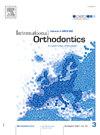Hypodontia as a predictor of third molar agenesis: A comparative cross-sectional study according to sex and tooth type in a French orthodontic population
IF 1.9
Q2 DENTISTRY, ORAL SURGERY & MEDICINE
引用次数: 0
Abstract
Objectives
The aim of this study was to determine the patterns of third molar agenesis and to investigate potential relationships with the agenesis of other permanent teeth, the type of missing teeth, and sex.
Methods
Panoramic radiographs from 4081 orthodontic patients aged 11 to 21 years were examined to identify non-syndromic tooth agenesis, including third molars. McNemar's Chi-square tests were used to compare the prevalence of third molar agenesis between jaws or sides. Logistic regression analyses were conducted to explore associations between the occurrence or patterns of third molar agenesis and potential explanatory factors.
Results
Third molar agenesis was observed in 19.0% of the sample (19.3% for females and 18.7% for males). The most common patterns of third molar agenesis were bilateral absence of the lower third molars (16.8%) and all third molars missing (16.7%). Third molar agenesis was 3.92 (95% CI = 3.07–5.00; P < 0.001) times more likely to occur when other permanent teeth were congenitally missing. The congenital absence of maxillary lateral incisors was associated with the agenesis of third molars in the maxilla (OR = 3.93; 95% CI = 1.07–13.70; P = 0.034). At least one missing mandibular third molar was involved in the patterns associated with the agenesis of other permanent teeth. No sexual dimorphism was observed.
Conclusion
Third molar agenesis appears to represent a continuum with the agenesis of other teeth, reflecting strong genetic control, affecting both sexes similarly.
下颌缺损作为第三磨牙发育的预测因素:一项根据法国正畸人群性别和牙型的比较横断面研究
目的本研究的目的是确定第三磨牙发育模式,并探讨与其他恒牙发育、缺牙类型和性别的潜在关系。方法对4081例11 ~ 21岁的正畸患者进行x线片检查,确定非综合征性牙发育,包括第三磨牙。采用McNemar卡方检验比较下颌或两侧第三磨牙发育不全的发生率。采用Logistic回归分析探讨第三磨牙发育的发生或模式与可能的解释因素之间的关系。结果第三磨牙发育不全率为19.0%(女性19.3%,男性18.7%)。第三磨牙发育最常见的类型是双侧下第三磨牙缺失(16.8%)和全部第三磨牙缺失(16.7%)。第三磨牙发育为3.92 (95% CI = 3.07-5.00;P & lt;当其他恒牙先天缺失时,发生的可能性要高出0.001)。先天性上颌侧切牙缺失与上颌第三磨牙发育不全相关(OR = 3.93;95% ci = 1.07-13.70;p = 0.034)。至少有一颗下颌第三磨牙的缺失与其他恒牙发育不全有关。未观察到两性异形现象。结论第三磨牙发育不全与其他牙齿发育不全具有连续性,反映了较强的遗传控制,对两性的影响相似。
本文章由计算机程序翻译,如有差异,请以英文原文为准。
求助全文
约1分钟内获得全文
求助全文
来源期刊

International Orthodontics
DENTISTRY, ORAL SURGERY & MEDICINE-
CiteScore
2.50
自引率
13.30%
发文量
71
审稿时长
26 days
期刊介绍:
Une revue de référence dans le domaine de orthodontie et des disciplines frontières Your reference in dentofacial orthopedics International Orthodontics adresse aux orthodontistes, aux dentistes, aux stomatologistes, aux chirurgiens maxillo-faciaux et aux plasticiens de la face, ainsi quà leurs assistant(e)s. International Orthodontics is addressed to orthodontists, dentists, stomatologists, maxillofacial surgeons and facial plastic surgeons, as well as their assistants.
 求助内容:
求助内容: 应助结果提醒方式:
应助结果提醒方式:


